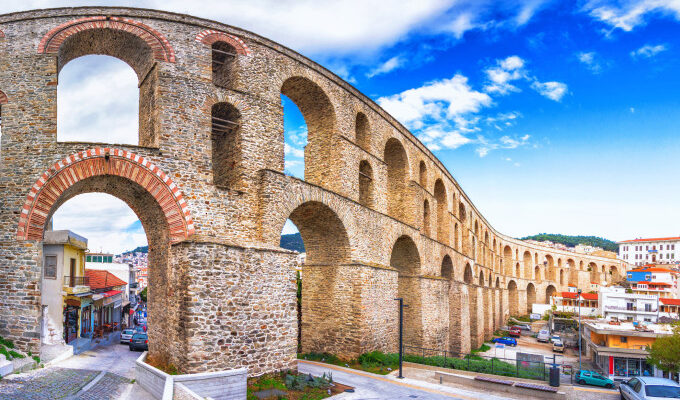The Old Aqueduct, also known as Kamares, is a well-preserved aqueduct in the city of Kavala and is one of the city’s landmarks.
While the aqueduct is probably of Roman origin, the current structure dates to the 16th century. It’s an early 14th century Byzantine wall, built as part of the fortifications on the Kavala citadel, probably also served as an aqueduct. If so, it would be a rare example of a Byzantine aqueduct, since Byzantine cities more commonly used wells and cisterns rather than maintaining existing Roman aqueducts or building new ones. The dam wall was replaced with the present arched aqueduct during the repair and improvement of the Byzantine fortifications of Suleiman the Magnificent. During the same period, restorations were carried out in other monuments of the city and Constantinople. Some authors date the construction to 1522 of the siege of Rhodes, but a more likely date is between 1530 and 1536. Until 1911, it was still used to supply the city with drinking water from the area of Old Kavala, at an altitude of 400 meters.
The Kamares have a maximum height of 25 meters. It rests on 18 massive mezzanines, and has a double, in some places triple, row of superimposed arches. It was built to bridge the low part that separates the peninsula of Panagia from the opposite mounds. The duct is 6 kilometers long, starts from the so-called “Mother of Water” and reaches the city through bridges and reservoirs. The whole southern part and part of the northern end were restored. Two inscriptions in Arabic and Greek certify that everything was carried out in 1818, financed by Mehmet Ali. The aqueduct is made of granite and clay elements.
It is divided into three sections. The lower tier consists of almost square piers, 6 meters wide, and single arches. The middle tier includes alternating single and double arches, while in the upper tier is the water duct.
There are two water tanks, one at the northern and one at the southern end, in which the water was stored with the help of the overflow system. The water from the tanks was then distributed to the city and to public fountains, public buildings and a few private homes.
In 1912, the Bulgarian authorities repealed the protective measures and turned the aqueduct into a road. The traversal of pedestrians, herds and carriages caused damage and cracks in the duct, resulting in the loss of water and frequent water contamination.
Copyright 2023 © Created By Diadyktio, All Rights Reserved.
To provide the best experiences, we and our partners use technologies like cookies to store and/or access device information. Consenting to these technologies will allow us and our partners to process personal data such as browsing behavior or unique IDs on this site and show (non-) personalized ads. Not consenting or withdrawing consent, may adversely affect certain features and functions.
Click below to consent to the above or make granular choices. Your choices will be applied to this site only. You can change your settings at any time, including withdrawing your consent, by using the toggles on the Cookie Policy, or by clicking on the manage consent button at the bottom of the screen.

Congratulation!